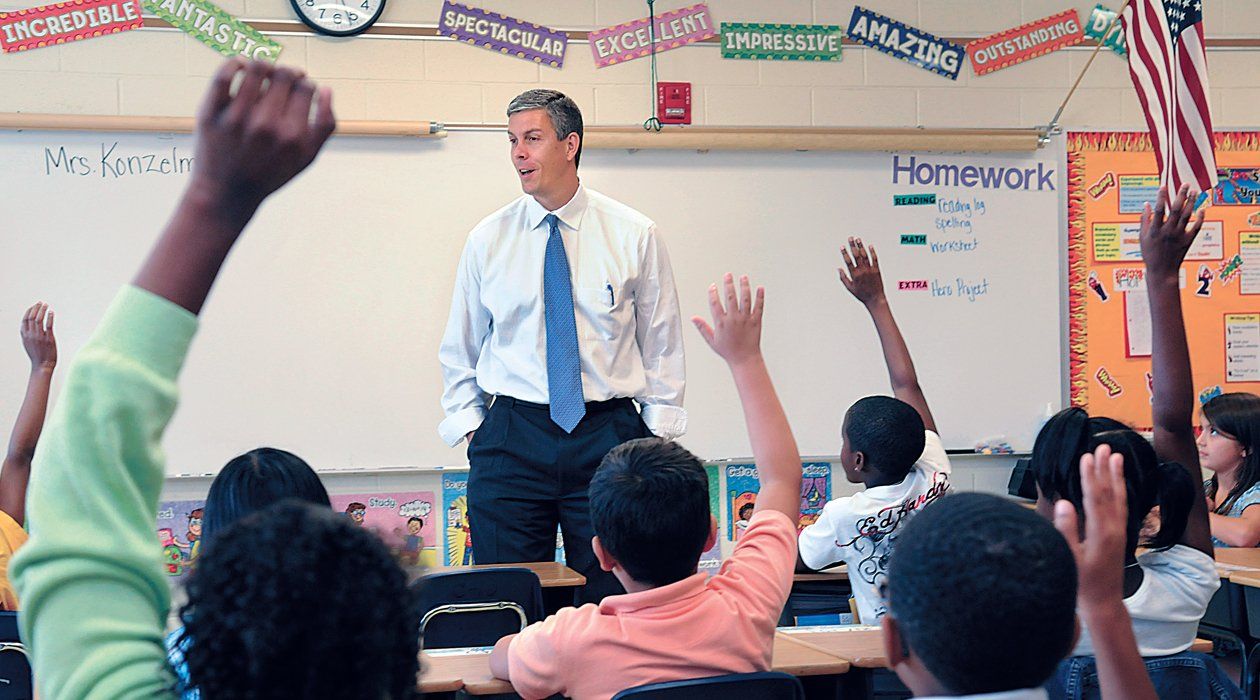
Arne Duncan, 46, a 6-foot-5 former basketball player (he played professionally in Australia), was on the Harvard team that set the NCAA record for highest free-throw percentage. He and his teammates, he jokes, shot well only when no one was guarding them. As secretary of education, he has grades K through 12 in a full-court press. Duncan says No Child Left Behind got things "exactly wrong" by being "loose on goals but prescriptive about how to get to them," which marks him as a friend of federalism.
Some of the $4 billion in Race to the Top funding—incentives for innovations—has been used to prod states to repeal laws that prohibited linking teacher evaluations to students' achievements. The family is the smallest school, but as the late Daniel Patrick Moynihan said, "Children don't think up algebra on their own." It is, Duncan acknowledges, inequitable for teachers to be held accountable for test scores of students from poor or broken homes, but it can be fair to link teachers' evaluations to students' improvements, controlling for poverty and other socioeconomic conditions.

Duncan says it is "easier to move the bottom than the top"—easier to make marked improvements in failing schools than in proficient ones. Hence the need for incentives to get good teachers to go to the worst schools.
Children can meet many states' standards for proficiency, Duncan says, and yet have no realistic hope of flourishing in college. Indeed, he says, "most" U.S. high-school graduates are "unprepared" for college. Duncan believes more rigorous state standards are necessary "to get higher education out of the remediation business."
Funding for grades K through 12 comes in large measure from property taxes, and the housing crash depressed property valuations. But budget problems confronting municipalities can, Duncan thinks, have benefits because "when you're flush, you keep doing the same things."
America's per-pupil spending is higher than that of the 34 OECD nations except for Luxembourg. "Students in Estonia and Poland," Duncan says, "perform at roughly the same level as those in the U.S., even though Estonia and Poland spend less than half as much per student." But many higher-performing countries emphasize higher teacher salaries rather than smaller class sizes.
Although teachers' unions are eager to shrink class sizes, thereby increasing the demand for more dues-paying teachers, Duncan knows there is no strong correlation between smaller class sizes and increased learning—other than when teaching reading in grades K through three. Money follows pupils in school funding, so Duncan says: Suppose a principal could tell excellent teachers that if they will accept a class size of 25 rather than 23, they will receive half the money attached to those two places. Or suppose that by using technology, particularly the Internet, a superior teacher of an Advanced Placement class can teach it in four schools simultaneously.
The Economist recently reported that in Singapore (ranked second internationally in math performance by 15-year-olds; America ranks 25th), applicants to the teacher-training program must be in the top 30 percent of their academic class. In South Korea, teachers are drawn from the top 10 percent of college graduates. In America, only 23 percent of new teachers come from the top third. According to a National Academy of Sciences study, "the average student intending to major in education in United States universities ranks in the 42nd percentile of all students taking the college boards in Critical Reading, in the 41st in mathematics and in the 46th in writing."
More than half of America's 3.2 million teachers and principals are baby boomers nearing retirement. A source of excellent replacements is Teach for America, which Duncan says has "broken the monopoly" of education schools and departments over the supply of teachers. Although the latter still produce 60 percent of teachers, Duncan says "many if not most" of those schools and departments are "doing a mediocre job."
Founded in 1990 by Princeton's 22-year-old Wendy Kopp, Teach for America last year received applications from 12 percent of Ivy League seniors. When Duncan was Chicago's school superintendent, one third of the principals hired at innovative new schools, charters, and others were Teach for America alumni. There are 95,000 schools in America, and, Duncan says, "if we had 95,000 good principals, we'd be done." Done, that is, worrying about K-through-12 education.
George Will is also the author of One Man's America: The Pleasures and Provocations of Our Singular Nation and With a Happy Eye But . . .: America and the World, 1997—2002.
Uncommon Knowledge
Newsweek is committed to challenging conventional wisdom and finding connections in the search for common ground.
Newsweek is committed to challenging conventional wisdom and finding connections in the search for common ground.
About the writer
To read how Newsweek uses AI as a newsroom tool, Click here.








